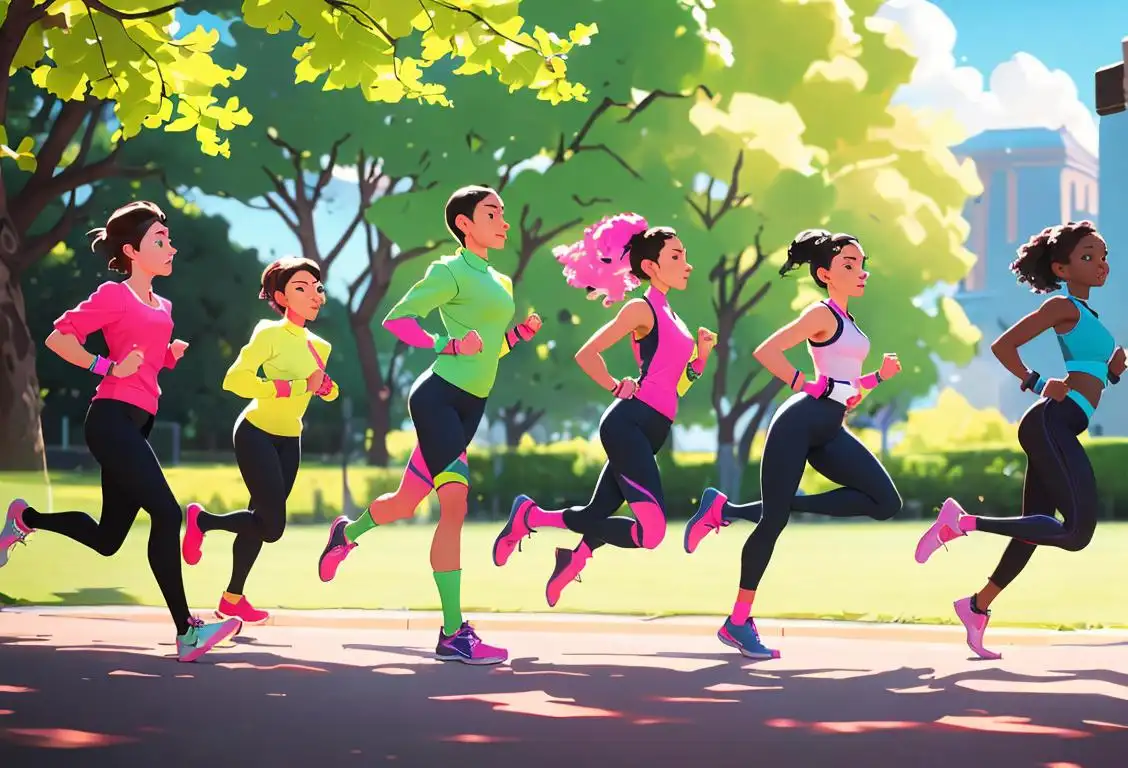National Foam Rolling Day

Welcome, foam roller enthusiasts! Today, we delve into the fascinating world of National Foam Rolling Day. Get ready to roll with the foam and feel the tension melt away. Let's dive in!
When is Foam Rolling Day?
It's national foam rolling day on the 11th May.
A Brief History of Foam Rolling
On this delightful day, we honor the foam roller, that cylindrical wonder designed to massage your muscles and relieve tension. But where did foam rolling originate? Well, it all began when someone cleverly thought, 'Hey, what if we take this foam and wrap it around a tube?' And just like that, the foam roller was born.
Although the exact origins remain a mystery, foam rolling gained popularity in the fitness and wellness community in recent years. Athletes, fitness enthusiasts, and even those suffering from tight muscles embraced foam rolling as a self-massage tool.
Your foam roller, dear reader, is not just any ordinary piece of foam. It's a secret weapon against muscle soreness, stress, and stiffness. So, grab your foam roller and let's foam roll our way to blissful relaxation.
The Benefits of Foam Rolling
Foam rolling offers a plethora of benefits for both your physical and mental well-being. Here are just a few:
- Muscle Recovery: Foam rolling aids in muscle recovery by improving blood circulation, breaking up knots, and reducing muscle soreness after intense workouts.
- Flexibility and Range of Motion: Regular foam rolling can help increase flexibility and improve your range of motion. So, say goodbye to feeling like the Tin Man from 'The Wizard of Oz' and hello to supple movements.
- Stress Relief: There's something uniquely soothing about rolling on foam. As you glide along the roller, tension gradually releases, leaving you feeling more relaxed and less stressed.
Now, you might be wondering, 'Is foam rolling painful?' Well, it can be a tad uncomfortable, especially when targeting those bothersome tight spots. However, like a worthy warrior, you'll emerge stronger and more energized after conquering the foam roller.
Get Rolling!
Are you ready to embark on a foam-rolling adventure? Follow these simple steps:
- Find a comfortable spot to foam roll. Your living room, garden, or even a cozy corner of your office will do just fine.
- Position the foam roller under the desired body part, whether it's your calves, quads, or back.
- Gently roll your body over the foam roller, applying enough pressure to feel the stretch and release of tension. Remember, a light touch goes a long way.
- Take deep breaths and breathe out any stress or discomfort as you continue to roll. Ahhh, pure relaxation!
And there you have it! You've officially become a foam rolling aficionado. Enjoy this National Foam Rolling Day by treating your muscles to a well-deserved massage.
History behind the term 'Foam Rolling'
1980s
The birth of foam rolling
Foam rolling originated in the 1980s as a form of self-myofascial release (SMR) therapy. It was primarily used by physical therapists, trainers, and athletes to treat muscle tightness and increase flexibility. The concept of using a cylindrical foam roller to apply pressure and massage the muscles gained popularity as an effective technique for relieving muscle tension.
2000
The invention of the foam roller
In the year 2000, the term 'foam rolling' emerged as a result of the invention of the foam roller. Foam rollers were initially created for physical therapists as a tool to aid in the rehabilitation of injuries. The foam roller itself was made of dense foam and had a cylindrical shape, allowing users to apply pressure and massage their muscles.
2008
Introduction to the fitness industry
Around the year 2008, foam rolling gained popularity in the fitness industry. Fitness enthusiasts and athletes started incorporating foam rolling into their workout routines. Foam rolling was found to be beneficial in improving flexibility, increasing blood flow, and reducing muscle soreness. As a result, the term 'foam rolling' became more widely recognized within the fitness community.
1990s
Growing recognition in the fitness industry
During the 1990s, foam rolling began to gain recognition within the fitness industry. As studies and research supported the benefits of self-myofascial release, foam rolling became more widely accepted as a valuable tool for injury prevention, muscle recovery, and improving performance. Fitness enthusiasts and athletes started incorporating foam rolling into their pre and post-workout routines.
2012
Scientific research on the benefits of foam rolling
In 2012, several studies and scientific research were conducted to explore the benefits of foam rolling. Researchers found that foam rolling can effectively reduce muscle tightness, enhance joint range of motion, and potentially improve athletic performance. This scientific validation further popularized the term 'foam rolling' and its usage in both professional and recreational settings.
Early 2000s
Commercial availability and product advancements
In the early 2000s, with the increasing demand for foam rolling, companies began manufacturing foam rollers specifically designed for self-myofascial release. These rollers were made of high-density foam, providing an adequate level of compression and durability. The commercial availability of foam rollers made them accessible to a broader range of individuals, contributing to their growing popularity.
2015
Integration into sports and fitness routines
By 2015, foam rolling had become an integral part of sports and fitness routines. Athletes, from professional sports teams to weekend warriors, regularly utilized foam rolling to improve their recovery, prevent injuries, and optimize their performance. The term 'foam rolling' became widely associated with self-myofascial release, a practice that involves applying pressure to specific points on the body with the foam roller.
Mid-2000s
Integration into fitness and wellness industries
By the mid-2000s, foam rolling had become a mainstream practice in the fitness and wellness industries. Fitness centers, gyms, and personal trainers started incorporating foam rolling classes and workshops into their offerings. Additionally, foam rolling became a staple in physical therapy practices, rehabilitation centers, and sports performance facilities, further solidifying its place as a recognized therapeutic technique.
Present
Mainstream adoption and variations
In the present time, foam rolling has achieved mainstream adoption and is commonly practiced by individuals of various fitness levels. The term 'foam rolling' is now deeply embedded in the fitness lexicon and is recognized globally. Additionally, there are now various types of foam rollers available, including smooth, textured, vibrating, and even collapsible ones, catering to the diverse needs and preferences of foam rolling enthusiasts.
2010s
Online tutorials and social media trends
With the rise of social media platforms and online fitness communities in the 2010s, foam rolling gained significant attention and became a popular trend. Fitness influencers and trainers started sharing foam rolling tutorials, demonstrating various techniques and routines for different muscle groups. This increased accessibility and visibility led to a surge in individuals incorporating foam rolling into their fitness regimens.
Present
Continued growth and diversification
Today, foam rolling has become an integral part of many individuals' fitness routines and recovery strategies. It is considered a valuable tool for improving range of motion, relieving muscle soreness, preventing injuries, and enhancing overall athletic performance. With continued advancements in foam roller design and technology, such as vibrating and textured rollers, the practice of foam rolling continues to evolve and expand.
Did you know?
Did you know that foam rolling is also known as self-myofascial release? Myofascial what? Exactly! So roll on and impress your friends with your knowledge!Tagged
sports fitness wellnessFirst identified
11th May 2016Most mentioned on
11th May 2016Total mentions
484Other days
Foam Rolling Day
Running Running Day
Bike To Work Day
Swim A Lap Day
Gymnastics Day
Fitness Day
Health And Fitness Day
Beastmode Day
Health Through Fitness Day
Iyengar Yoga Day








